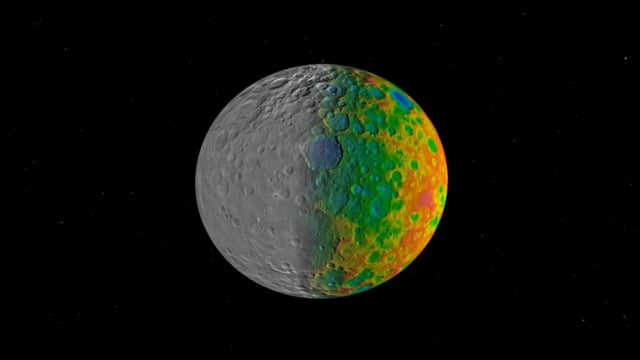
The dwarf planet Ceres – which must have been hit by numerous large asteroids during its 4.5 billion-year lifetime – has a mysteriously low number of large craters, scientists using data from NASA’s Dawn spacecraft have found.
Ceres is covered in countless small, young craters, but none are larger than 280 kilometres in diameter. A new study explored this puzzle of Ceres’ missing large craters, using data from the Dawn spacecraft, which has been orbiting Ceres since March last year. “We concluded that a significant population of large craters on Ceres has been obliterated beyond recognition over geological time scales, which is likely the result of Ceres’ peculiar composition and internal evolution,” said lead investigator Simone Marchi, a senior research scientist at the Southwest Research Institute in the US.
Researchers modelled collisions of other bodies with Ceres since the dwarf planet formed, and predicted the number of large craters that should have been present on its surface. These models predicted Ceres should have up to 10 to 15 craters larger than 400 km in diameter, and at least 40 craters larger than 100 km wide. However, Dawn has shown that Ceres has only 16 craters larger than 100 km, and none larger than 280 km across.
One idea about Ceres’ origins holds that it formed farther out in the solar system, perhaps in the vicinity of Neptune, but migrated to its present location. Scientists determined that even if Ceres migrated into the main asteroid belt relatively late in solar system history, it should still have a significant number of large craters. “Whatever the process or processes were, this obliteration of large craters must have occurred over several hundred millions of years,” Marchi said.
Dawn’s images of Ceres show that the dwarf planet has at least three large-scale depressions called “planitiae” that are up to 800 km wide. These planitiae have craters in them that formed in more recent times, but the larger depressions could be left over from bigger impacts.
One reason for the lack of large craters could be related the interior structure of Ceres. There is evidence from Dawn that the upper layers of Ceres contain ice. Since ice is less dense than rock, the topography could “relax,” or smooth out, more quickly if ice or another lower-density material, such as salt, dominates the subsurface composition.
Recent analysis of the centre of Ceres’ Occator Crater suggests that the salts found there could be remnants of a frozen ocean under the surface, and that liquid water could have been present in Ceres’ interior. Past hydrothermal activity, which may have influenced the salts rising to the surface at Occator, could also have something to do with the erasure of craters. The study was published in the journal Nature Communications.
[Source:- Dna]



